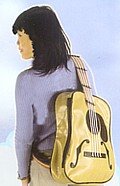Saturday, April 29, 2006
Go. Play.
"Check out this fabulous kids’ music site from the BBC. It’s full of great, fun, musical information, games, recordings, ring tones, mixers, sequencers, you name it—including detailed instructions on how to make armpit farts."
More about armpit farts and other interactive musical games online for kids.
One hit wonder
 In this video clip Jared Folk demonstrates his one-handed roll on the snare drum. Jared was a former piano student of Kindermusik Educator Darcie Brown, and she blogged this update about her former student this week.
In this video clip Jared Folk demonstrates his one-handed roll on the snare drum. Jared was a former piano student of Kindermusik Educator Darcie Brown, and she blogged this update about her former student this week.Marketing tip: Make a "graduate gallery." Ever run into your former students around town, or their parents? If they're up to something musical, and even if they're not, consider asking for a picture and making a "proud graduate" gallery in your studio, or your Web site online. Include little interesting tid-bits about their lives today and put it in a short, bio format. You could also mail those past families a postcard and ask for and update. Even if the child is only a few years out of Kindermusik, it could be the beginning of a gallery that you update year after year. For example:
Kindermusik graduate: Molly McGinn, 31
Kindermusik years: Our Time and Imagine That!
Favorite memory: Singing with my mom and dad in class and on the ride home
About Molly: Molly is a writer living in Greensboro, North Carolina. She plays guitar, piano, ukulele, and harmonica.
Thursday, April 27, 2006
Filmmakers on music
Music on the brain
 ...When Thomas Jefferson wrote the Declaration of Independence, he would play his violin to help him find the words...
...When Thomas Jefferson wrote the Declaration of Independence, he would play his violin to help him find the words...More interesting music bits in this Music and the Brain article.
Study in steady
 Ahmir "?uestlove" Thompson is one of the most intriguing percussionists of our time. I first saw him in Dave Chapelle's "Block Party USA." In the musical-comedy documentary, the Ohio based comedian stages a free concert in Brooklyn, NY.
Ahmir "?uestlove" Thompson is one of the most intriguing percussionists of our time. I first saw him in Dave Chapelle's "Block Party USA." In the musical-comedy documentary, the Ohio based comedian stages a free concert in Brooklyn, NY.Thompson mesmerizes me. The way he plays his drums, the way he holds his head--he's a study in steady. His eyes gently fixed, chin tipped just a bit, he shows a humble countenance that lets you know he's not playing for the crowd, or anyone else. When I watch him play it reminds how great it is to be able to play at all, to create, and be in the presence of music.
Play on.
You can hear Thompson on his new project featured in NPR's song of the day.
Wednesday, April 26, 2006
The Art of Possibility book club

Final chapters: Music lessons for the soul. We invite you to read along with us to discover the "practices" of creating possibility from The Art of Possibility by Benjamin and Rosamund Zander, keynote speakers at Kindermusik Convention 2006.
Dial in: 1-866-273-8312 or 1-336-369-1511. Space is limited!
June 30, 4 pm (EST) Code 63006
Topic: Lighting a Spark (Reach chapters 7–9)
Comical study in symbols
 Even the psychology professor at the University of Virginia says toddlers treating scale models like full-sized objects is one of the most comical behaviors she and her colleagues observe at their Child Study Center, according to an article today in Science Central.
Even the psychology professor at the University of Virginia says toddlers treating scale models like full-sized objects is one of the most comical behaviors she and her colleagues observe at their Child Study Center, according to an article today in Science Central. I watched the video in the article a while ago, and yep. It's funny. But the thought to ponder after the laughter is how a child develops awareness of scale and symbol at all. It happens only through interaction. The little one pictured here won't know she can't take this mouse-sized car for a ride until she realizes she can't even put her foot in.
The accompanied article also gives a great glimpse into the amazing mind of a toddler--one of my favorite ages for their emotionally sporadic, erratic behavior. These little big-bellied, wobbly wonders are master developers, and it's so much fun to watch.
Enjoy your toddlers today.
Tuesday, April 25, 2006
The story behind Tom Thumb and Kindermusik EP
 "Kindermusik EP" is the name of the new Indie Rock album by singer and songwriter Tom Thumb. Here's what he said about why he named the new album Kindermusik:
"Kindermusik EP" is the name of the new Indie Rock album by singer and songwriter Tom Thumb. Here's what he said about why he named the new album Kindermusik:"We recorded in a church in Maine, holed up over a weekend. The church's sign out front said 'Kindermusik' in those movable marquee letters. It looked like it had said that for years, but from our perspective it was an announcement of what was playing in the church that weekend. So that's what we named the record. Plus most of the songs come from a group of songs I wrote about aging. It seemed appropriate. It's where the 'Latter Day Saints' as the backing band came from too. I've done solo stuff for a while and this was a record of me with a band- a straight representation of the live set, no overdubs and whatnot. So it's me and the Saints playing Kindermusik in a church. "
The album is available for sale on his Web site, or in iTunes. Search "Tom Thumb and the Latter Day Saints."
The photo is courtesy of Sooz on Flickr.
Ever wonder who works here?
 This is Chelsea Bass. Bass like the fish. I always say Bass like the instrument and she immediately corrects me. I'll get it right some day.
This is Chelsea Bass. Bass like the fish. I always say Bass like the instrument and she immediately corrects me. I'll get it right some day.Her official title is Curriculum Development Specialist for Kindermusik International. That basically means that Chelsea is the spiral-bound ringer in your Teacher's Guide--she holds everything together. She also has a real keyboard at her desk, the piano kind, not the typing kind.
She's Carol Penney's right hand, er, girl, er, lady. Woman, I mean. She has also single-handedly replaced the roof on her house, retiled her kitchen, and she's an excellent piano teacher and just this year, a new Young Child Kindermusik Educator.
Kindermusik goes Indie Rock
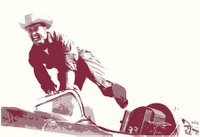 A morning search on Technorati pushed up this picture fronting an album review on Tom Thumb and the Latter Day Saints. Now here's the Kindermusik connection. According to the review via punk music blog Smother:
A morning search on Technorati pushed up this picture fronting an album review on Tom Thumb and the Latter Day Saints. Now here's the Kindermusik connection. According to the review via punk music blog Smother:"Tom Thumb is a melodic singer/songwriter - a solo artist. This winter he and some other musicans held a little live session in a church in Maine and - what luck - somewhere there must have been a recording machine. The sum of this session was banned on a 8-Track EP which will shortly be released on THREE RINGS RECORDS and will be called 'Kindermusik.' Isn’t that cute?"
Monday, April 24, 2006
Movie-making debut
 Executive Music Producer David Huff and I wrote the song, a local artist drew the pictures, and we threw them into iMovie. Today I finally realized, "drrr. I can put this on You Tube."
Executive Music Producer David Huff and I wrote the song, a local artist drew the pictures, and we threw them into iMovie. Today I finally realized, "drrr. I can put this on You Tube."Here it is. A music-literature video, or something like that. I know it's not exciting enough for the kiddies to watch, but it's a start.
Thursday, April 20, 2006
It's all connected
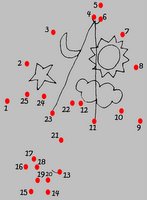 Convention, the book club, a PDS—it’s all connected.
Convention, the book club, a PDS—it’s all connected.Dot #1: The Art of Possibility book club. This month we'll start the free book club for Kindermusik Educators via teleconference.
Dot #2: The Art of Possibility authors are featured keynote speakers at this year’s Kindermusik Convention.
Dot #3: The book was a major inspiration to the Speaker’s Bureau at last year’s city-to-city Kindermusik Educator training, Professional Development Series.
Dot #4: Katie Henderson is leading The Art of Possibilty book club. And Katie has been a tireless advocate for Educator training and a member of the Speaker’s Bureau. She’s also proof of the possbilities. She's owner and director of Music Connections of Bloomington-Normal, Illinois. She’s a mom, she has a new puppy she rescued from Nashville, TN, and she quotes Maya Angelou in her email signature.
“This book was a major resource for last year’s Professional Development Series, Catch the Spark, and provided, in my opinion, some of the most impactful educator learning and attitude shifts I’ve ever witnessed.”She’s another Wonder Woman, too (see Wonder Woman post below).
Educator bloggers--look to the right
 If you look in the right-hand column under my photo you'll see a list of links. Each one links you to other Kindermusik Educator blogs. Today I did a little grooming and cleaned out some links that haven't been quite as active. That's because this list is meant to provide great examples of how much fun a blog can be, and how well it can communicate the benefits of a musical, multi-sensory education to parents.
If you look in the right-hand column under my photo you'll see a list of links. Each one links you to other Kindermusik Educator blogs. Today I did a little grooming and cleaned out some links that haven't been quite as active. That's because this list is meant to provide great examples of how much fun a blog can be, and how well it can communicate the benefits of a musical, multi-sensory education to parents.I added one new blog today: Erin Wilson's The Music Studio. Erin was recently featured on The Patnership of Kindermusik Educators blog and has provided some great comments on the Family Time blog.
Wednesday, April 19, 2006
Transform yourself—the book club

If Linda Carter can do it, I can. I have the music, the original audio clip from the show when Linda transforms herself into Wonder Woman. Only I didn’t have the book, or the book club--to do it.
Begin transformation (play audio clip): The Art of Possibility: Transforming Professional and Personal Life book club begins this month. We’ll be reading the book co-authored by this year’s Convention keynote speakers Benjamin Zander and Rosamund Stone Zander.
The whole point of the book is transformation. To stop talking about the person you want to be, and be that person. Yep. I’ll be fighting crime from now on.
The Art of Possibility: Transforming Professional and Personal Life book club:
April: Giving an A (Read chapters 1–3)
May: Being a Contribution (Read chapters 4–6)
June: Lighting a Spark (Reach chapters 7–9)
Corresponding hosted teleconferences:
April 28, 2006 4PM EDT Code 42806
May 26, 2006 4PM EDT Code 52606
June 30, 2006 4PM EDT Code 63006
Dial in: 1-866-273-8312 or 1-336-369-1511. Space is limited!
Music makes kids jump higher, too
 “In a recent study, 4 to 6 year olds in a music and movement program showed more growth in motor skills than those in a standard physical education program. ... [Researchers] placed 50 children in an experimental music and movement program, and 42 in a traditional physical education program. After 8 weeks, the experimental group had improved significantly in both jumping and dynamic balance skills when compared to their peers in the traditional program.”
“In a recent study, 4 to 6 year olds in a music and movement program showed more growth in motor skills than those in a standard physical education program. ... [Researchers] placed 50 children in an experimental music and movement program, and 42 in a traditional physical education program. After 8 weeks, the experimental group had improved significantly in both jumping and dynamic balance skills when compared to their peers in the traditional program.”Early Childhood Research Quarterly (Vol. 19, Issue #4, 2004).
Now let's just take a moment here. I've had parents in class talk about how much their kid learns in Little Gym or Tumble Bus (how is that not a liability?) and I've never had a response on the tip of my tongue. Now I do. Aherm.
If you want a copy of the article, let me know and I’ll email it to you.
Tuesday, April 18, 2006
Give us a hand
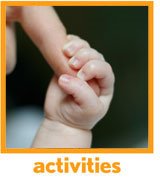 Tune In is a finalist this year for the Association of Educational Publishers award. That's sort of our version of the Pulitzers, or the Oscars. We’ll hear if it won anything later on at some fancy-schmancy awards banquet, but still, it’s an honor to be a finalist.
Tune In is a finalist this year for the Association of Educational Publishers award. That's sort of our version of the Pulitzers, or the Oscars. We’ll hear if it won anything later on at some fancy-schmancy awards banquet, but still, it’s an honor to be a finalist.Here’s the issue we submitted.
Read past issues, here.
Encourage parents to subscribe for Tune In (it's free for crying out loud). You can find the subscription link in the upper right corner of Tune In's home page, or you can send them this link. If that's not your thing, you could also read through past issues and use the ideas for filler in your newsletters, emails, and in your community demonstrations.
Listen to the world music in a child's mind
 This is Skyler Pia, and when he was 6 years old he started his own radio show of world music. One year later, he has his own album, "One World, One Kid," and something some people never get: A cause. Proceeds from his album support the Make-A-Wish-Foundation.
This is Skyler Pia, and when he was 6 years old he started his own radio show of world music. One year later, he has his own album, "One World, One Kid," and something some people never get: A cause. Proceeds from his album support the Make-A-Wish-Foundation.Listen to Skyler's story on NPR.
Monday, April 17, 2006
Thursday, April 13, 2006
The first lady of children's folk music
 The first time I heard Ella Jenkins sing in that low, storied voice, with a sound as deep as her history is long, with a pretty patina made more beautiful from over five decades of singing for children, I knew I'd found my inspiration. Forget the Wiggles. Forget Barney. Forget Laurie Berkner. Ella is proof that yelling and wiggling isn't always necessary to get a child's attention.
The first time I heard Ella Jenkins sing in that low, storied voice, with a sound as deep as her history is long, with a pretty patina made more beautiful from over five decades of singing for children, I knew I'd found my inspiration. Forget the Wiggles. Forget Barney. Forget Laurie Berkner. Ella is proof that yelling and wiggling isn't always necessary to get a child's attention.Take Ella Fitzgerald's clarity, Billie Holiday's grit and put it on the playground--that's Ella's voice. She'll give you rhymes to remember the names of continents, stories about "rushin' around in Russia," and poems to make roses bloom and teach you Spanish. The self-taught musician was discovered on the street where she performed, and she's proof that a good teacher is always found in the most suprising places. She still tours and performs, too. She'll be 82 this August.
A short, concise Ella bio.
Ella's homepage.
Listen to Ella's music.
Wednesday, April 12, 2006
What's in your Kindermusik?
Tuesday, April 11, 2006
While my ukulele gently weeps
 Via the Neatorama blog, a ukulele sings the Beatles.
Via the Neatorama blog, a ukulele sings the Beatles."The ukulele is a symbol of innocent merriment." Paradise of the Pacific, 1917.
Make a sidewalk musician map
 Now that the weather's warmer, I'm back singing and playing guitar on the sidewalks again. Something about playing on the street steels up the nerves. You have to play louder and get over yourself. Your street banter and improv with perfect strangers improves. You play more for the moment and let the street sounds, and the people walking by dictate the set list.
Now that the weather's warmer, I'm back singing and playing guitar on the sidewalks again. Something about playing on the street steels up the nerves. You have to play louder and get over yourself. Your street banter and improv with perfect strangers improves. You play more for the moment and let the street sounds, and the people walking by dictate the set list.Any sidewalk players in your city? Ask your families if they know where any sidewalk players play. Then take a map and circle all the locations they mention. Add little interesting facts. For instance, one sidewalk sax player in downtown Raleigh, NC, named Freddy carried a jar full of dirt from John Coltrane's old home place. Make copies and give the maps to families.
No sidewalk players in your city? Be one.
Monday, April 10, 2006
Thanks Merri
"Sounds like tendonitis. I get it periodically in my wrists as well as my elbows (pianist/flutist here). Doctor's recommendation was 2 ibuprofen 3x a day for a week with warm, moist heat applied twice a day."
Happy Birthday Beverly Cleary

The children's book author and creator of the often misunderstood and mischievous character--Ramona Quimby--turns 90 this week. To this day I think about Ramona when I check the sidewalks and streets after the rain to see if it's dry enough to skate over to Starbucks for coffee.
Friday, April 07, 2006
Are you mocking me? Good.
 Next time one crying baby sets off a chorus of cries, take pause. Empathy is developing in those little minds right before your very eyes.
Next time one crying baby sets off a chorus of cries, take pause. Empathy is developing in those little minds right before your very eyes.How empathy develops. The window for empathy begins to narrow at about eighteen months of age when the newest evolutionary addition to the neocortex (the brain’s massive frontal lobes, which occupy the area in back of the forehead), finish their basic hookup to the emotional limbic system.
Attunement—how you reinforce empathy. Attunement is the natural instinct on the part of the caretaker to respond to and imitate the baby through mirroring the emotion, or playing back of the child’s inner feelings. If these feelings are reinforced, the nerve tracts carrying them will sprout new connections and myelinate. If not, they will weaken.
How you know empathy is developing. An infant who has been mirrored and comforted develops the ability to empathize even before she is aware of her own independent existence. Newborn babies show a limited type of empathy by crying when they hear another infant in distress, a reflex called motor mimicry, which soon gives way to more attempts to console others.
What to do: If a child falls down and cries she will develop empathy when a parent mimmicks her hurt, then picks her up and soothes her. Mimic or mirror the behaviors, expressions, and vocalizations of a child, even happy ones. Doing so strengthens the tracts the child’s frontal lobes and limbic system.
Other odd empathy facts:
Newborn babies are born pre-wired to respond to human touch, speech, and facial patterning.
Only hours after birth the infant moves her body in a precise synchrony with the speech patterns of her caretaker.
3-4 months: A baby prefers human voices and faces.
Six or seven months: Can mimic other emotions, and hopefully is mimicked in return.
Paraphrased from "A Woman's Book of Life, The Biology, Psychology, and Spirituality of the Feminine Life Cycle," Joan Borysenko, Ph.D.
Critical windows for learning

A few noteworthy “critical windows” for early mind development (brain is such a mad lab word, you know? I like mind, better).
- Vision. Actively begin to sprout connections between 2 to 4 months and complete their basic wiring by about 8 months
- Phonemes and language. Open through12 months
- Music. Closes around 10 years old and is closely related to the circuits required for math and logic
- Empathy. Narrows around 18 months
p 21-22, "A Woman's Book of Life, The Biology, Psychology, and Spirituality of the Feminine Life Cycle Joan Borysenko, Ph.D."
Thursday, April 06, 2006
Must. Stop. Arm. Hurts.
I found it on this half blog, half Web site (thanks Super Jessica) made of links to interactive songs, drawings, and other indescribable stuff on ze frank's page. He updates his blog each day with links to other interactive artists and their works.
Seriously, though. My arm hurts. Right in the elbow there. What do you guys do when the muscles in your arm crank up from playing too much guitar or piano? Drop me a line.
Save the Music newsletter
Wednesday, April 05, 2006
Stop motion fun
 I love stop motion films. So when this little iFilm popped in my inbox via local film teacher and movie maker Stephen Van Vuuren, I had to share. Plus his theory is that film is a series of moving pictures. I’d amend the last bit to “pictures moving to music.”
I love stop motion films. So when this little iFilm popped in my inbox via local film teacher and movie maker Stephen Van Vuuren, I had to share. Plus his theory is that film is a series of moving pictures. I’d amend the last bit to “pictures moving to music.”
Tuesday, April 04, 2006
Ginger Ale goes through the nose, too
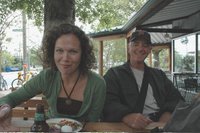 April is National Humor month. We're not talking the tee-hees or the snickers. We're talking full-on guffaws. I have a few friends who never fail to make me blow Ginger Ale through my nose (I don't like milk), which is exactly what's happening in this picture here as my friend, Super Jessica, is making me laugh and taking the picture.
April is National Humor month. We're not talking the tee-hees or the snickers. We're talking full-on guffaws. I have a few friends who never fail to make me blow Ginger Ale through my nose (I don't like milk), which is exactly what's happening in this picture here as my friend, Super Jessica, is making me laugh and taking the picture.Other people who double me over:
Rachel Cupery in Verona, Wisconsin (best friend since 7th grade)
Scott Cross, DRMY!'s Senior Writer
Kathryn Brown, DRMY!'s Consultant Loyalty Representative
My brothers Danny and Ryan
Literally, this morning, everyone at KI with a dramatic interpretation of life since we started Fish
Who's on your list?
“Laughter increases white blood cell activity and changes the chemical balance of the blood. This is believed to boost the body’s production of chemicals needed for alterness and memory. Laughter reduces stress, and low stress enhances the brain’s receptivity to learning. According to researchers, laughing (having fun) also boosts the body’s immune system for three days – the day of the fun and the next two.” --Start Smart!: Building Brain Power in the Early Years by Pam Schiller
For more, check out this old issue of Tune In on how music develops humor.
If you listen...
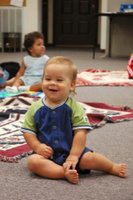 You'll hear that the music sounds a little sweeter in heaven today. Carson White, pictured here in Kindermusik class, passed away Saturday night.
You'll hear that the music sounds a little sweeter in heaven today. Carson White, pictured here in Kindermusik class, passed away Saturday night.The White family
508 Chatsworth
Montgomery, AL 36109
Donations:
Carson’s family or Carson’s Scholarship
Eastwood Presbyterian Church
Attn: Bob Maruna
1701 East Trinity Blvd
Montgomery, AL 36106
Ideas are like stars
 What good is a good idea, if you can't see it? No good. So when one Educator emailed this morning and asked if she could use the dandelion ideas for her newsletter, I said, "heck ya." Absolutely. Everything on this blog I write for Kindermusik Educators and their families, in the hope, that in turn, they'll find it interesting enough to share with a child.
What good is a good idea, if you can't see it? No good. So when one Educator emailed this morning and asked if she could use the dandelion ideas for her newsletter, I said, "heck ya." Absolutely. Everything on this blog I write for Kindermusik Educators and their families, in the hope, that in turn, they'll find it interesting enough to share with a child.So share it. Use anything you like here for emails or enewsletters. If not, draw it in chalk on the sidewalk, or hire a skywriter and write it in the sky (only if you do that, call me, I want a picture, or a ticket to ride).
I know there are some even better ideas out there than mine. Toss them up so we can all see them.
Monday, April 03, 2006
Dandy games
 I didn't have a camera, but still, this picture is pretty close to what I saw yesterday afternoon, resting in the grass after a long, winding run on the longboard. And it inspired me today to find these dandelion games. Share and try with anyone you like. Happy spring.
I didn't have a camera, but still, this picture is pretty close to what I saw yesterday afternoon, resting in the grass after a long, winding run on the longboard. And it inspired me today to find these dandelion games. Share and try with anyone you like. Happy spring.Babies. Let them watch you blow the dandelions. Like watching soap bubbles, watching the scattering seeds can be relaxing, and a good visual tracking exercise. As you blow the seeds, talk to your baby about where they go. Use descriptive, rhythmic language about even the most ordinary things and it helps your child develop storytelling skills.
Toddlers. In the process of developing lung and breath control, let your toddler blow the dandelion seeds. If that isn't working, blow dandelions seeds so your toddler can chase the little puffy parachutes.
Preschoolers. Use dandelion flowers for paintbrushes. Or, a dandelion can help your preschooler wind down. In the fight to stay awake and learn, preschoolers can have a hard time slowing down. Try this: Ask your preschooler to pretend that he’s a dandelion whirligig. Blow on his cheek, and let him take off fast in a burst, then slowly, drift to the ground. This music clip will add a little more imagination to the mix.
Young Child. Make a spring scavenger hunt of things you can only find in the spring: 3 puffy dandelions, 3 dandelions that have bloomed, 4 rocks, 3 blades of grass, etc. Or, sit together and look up dandelion facts on Wikipedia.
Straight off the 'net: Games to play down by the river
Get a seeded dandelion (one that's gone all white and fluffy) and blow on it. The number of blows it takes to blow all the seeds off is the time (so four blows means it's 4 o'clock) which, while patently untrue, is a cute concept.
A popular children's variation is to attempt to catch the seeds as they float through the air. If successful they can make a wish as the little white bit at the bottom is a tiny fairy which is hitching a lift!


